ABCs: Herald Sun is first title to see drop in digital subscribers
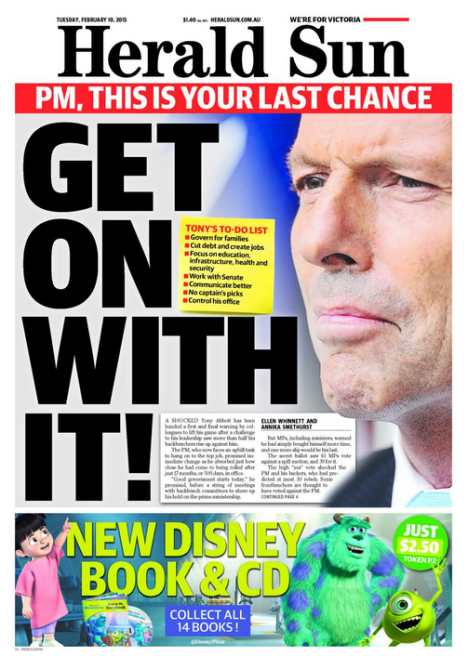 The Herald Sun has become the first masthead to record a quarter-on-quarter decline in digital sales, newly released numbers reveal.
The Herald Sun has become the first masthead to record a quarter-on-quarter decline in digital sales, newly released numbers reveal.
The News Corp title saw the number of subscribers to its paywall fall by 1.85% from 50,360 to 49,425, according to the Audit Bureau of Circulations data.
It was the first time that any Australian newspaper site’s audited paywall subscriber numbers have gone backwards, after it put up a paywall, compared to the previous quarter.
In a statement, News Corp CEO Julian Clarke said of the Herald Sun’s drop: “The last quarter’s number was negatively affected by a price increase (from $7.99 to $23.99) for people who subscribe via the iTunes app.”
The numbers are part of a trend towards a levelling off of digital subscription take up across the board.
Fairfax’s Sydney Morning Herald increased its reported digital subscriber numbers by just 1.75 per cent in the quarter to 135,274.
And sister publication The Age rose by 1.38 per cent to 135,776 subscribers.
News Corp’s The Australian increased its quarterly digital subscriptions by just 173 subscribers – or 0.26 per cent – to 65,739 subscribers.
“The price rise from $4 to $6 per week in digital, which flowed through to all existing members last quarter, resulted in a slight churn uptick as we expected,” said Gray.
“Of course, we also equalised our pricing across all digital entry points, so The Australian’s iTunes price went from $12.99 to $23.99 per month, which also had an impact.
“Clearly with slight volume growth and 50% price growth, our digital subscription revenues are growing rapidly.”
News Corp still does not release digital subscriber numbers for the Daily Telegraph, Courier Mail, Adelaide Advertiser and Hobart Mercury, while rival Fairfax does not disclose the Australian Financial Review’s subscription numbers.
Every metro and national newspaper saw a year-on-year decline in print circulation.
The Australian saw a fall of 6.7 percent of its weekday circulation.
The Herald Sun saw its print circulation post an 8 per cent decline, shedding 31,213 weekday copies compared to a year before.
The Age fell by 18.3 percent in its weekday print circulation.
The Sydney Morning Herald saw a 13 percent year-on-year decline in print while Sunday sister title the Sun-Herald fell 14 percent.
Fairfax’s title national business newspaper The Australian Financial Review posted an 8 per cent decline in weekday print circulation and an 11.3 per cent weekend decline.
Amongst the other metro titles, Seven West Media’s The West Australian posted the smallest decline, down 4.8 per cent, followed by the Courier Mail in Brisbane with a 5.3 per cent decline, the Canberra Times which fell 6.7 per cent and Sydney’s Daily Telegraph which recorded a 6.9 per cent decline.
The Saturday newspapers saw more consistent decline with most newspapers falling between 8-9 per cent.
The only newspaper to defy that trend was Sydney’s Daily Telegraph which posted only a 3.9 per cent decline in print circulation on the Saturday, recording sales of 275,380.
Sunday newspapers also posted notable declines across the board with News Corp’s Sunday Telegraph recording a 6.8 per cent decline with sales of 523,123.
Asked to comment on the print circulation results a spokesman for Fairfax emphasised previous statements promoting the EMMA readership platform: “We continue to grow digital subscriptions, innovate and build value into our subscriptions based on an understanding of the changing needs of our customers.
“Our print circulation is more profitable than ever. Profitable circulation and our fiercely independent journalism and content, ensures that the print editions of our mastheads continue to contribute to the growth and engagement of our audience.
“It’s important to note that circulation data only shows part of the picture of the reach of our print and digital mastheads. Readership shows true engagement with our products.”
News Corp also played down the circulation declines by highlighting its results in the EMMA survey.
“Although circulation of printed newspapers has marginally declined, it is more than replaced by significant growth in digital readership which has driven the 2.5 per cent growth year on year,” said Clarke.
“The recently released EMMA data shows that we have experienced growth in readership of around 2.5 per cent across all platforms over the last 12 months.”
Nic Christensen

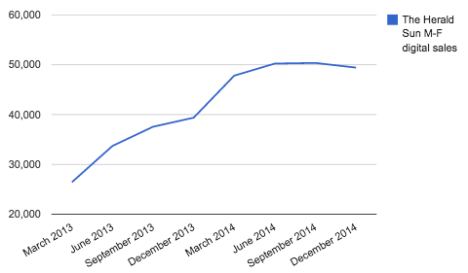
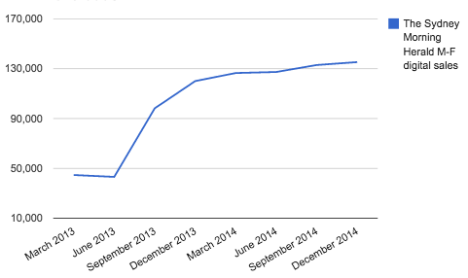
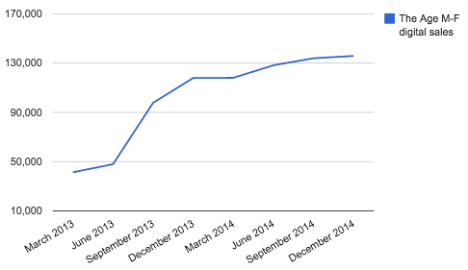
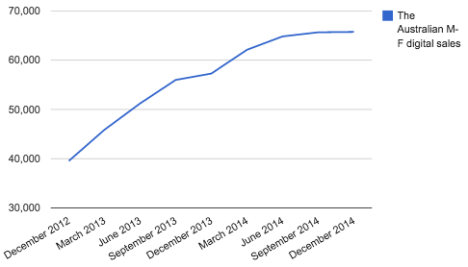






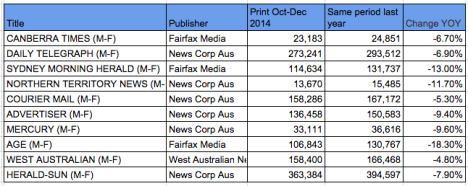
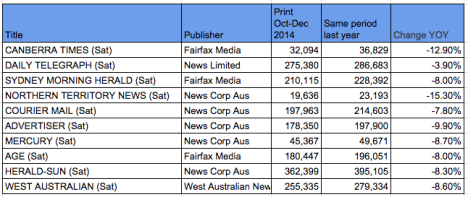
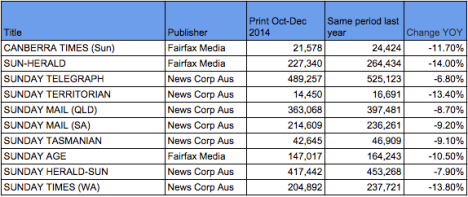

Even the spin is awful. The Australian says 6.7% loss is a stabilising trend. AFRis near terminal for print, given its logistics. And the Fairfax “reach” nonsense beggars belief !
If this is the best these folk can do its time to get some new people at the top.
Interesting the Oz digital only grew by 176 subs, I was one of them ( I expect a personal thank you note and gift basket from Rupert any day now).
I took up a discounted sub offer, 12 weeks for $1. Seems their discount promo’s aren’t pulling in the punters.
@Henry Jones: the fact that they have to resort to this sort of deep discounting just to practically stay still in terms of digital subscriber numbers speaks volumes. Similar for the Fairfax mastheads : they have been offering half price digital subscriptions for months now, and still only achieved anaemic growth in the last quarter. I’m guessing their churn rates must be high. And as for the weekday circ figures for Fairfax print — diabolical.
Liam, agreed. A smart consumer with a spare moment and a calendar reminder might even churn thru their offers… dumping as the discount period ends and the full fee looms and signing up for the latest discounted offer… I have plenty of email accounts and credit cards, not that I would do that of course. 😉
RIP Canberra Times
It takes five seconds to delete smh and Fairfax from my cookies through my Mac privacy settings while News Ltd the same with telegraph and new. Many other mags use the same kind of cookie formula.
These numbers are fine as 482* people now read each printed and digital copy on average.
If it takes the death of all the Newspapers in this country to kill off Murdoch’s influence over our society and its goverance then it will have been a price worth paying.